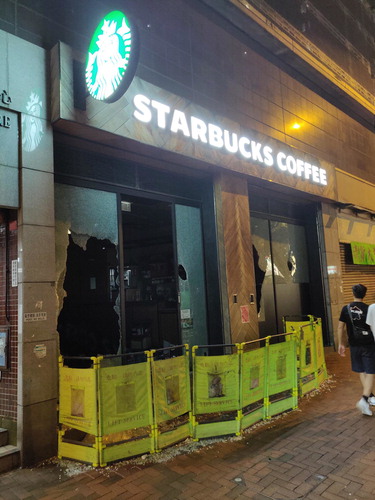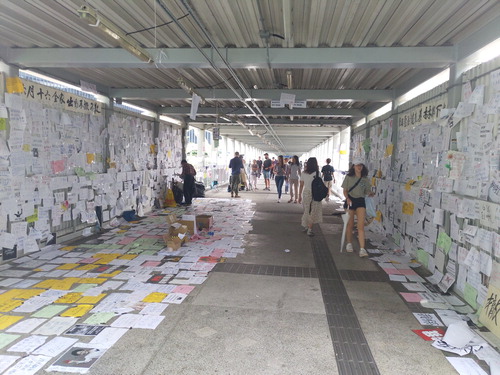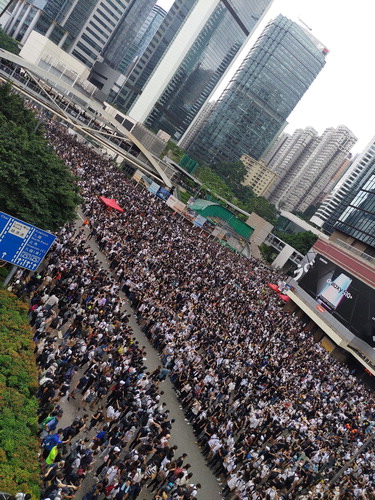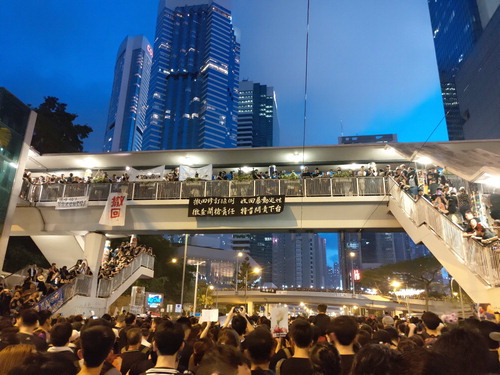Abstract
Hong Kong citizens’ fierce and evolving struggles, developing from the summer of 2019 onwards, have spawned countless stories, protest tactics, sacrifices, and debates in Hong Kong society and beyond. In this article, we probe Hong Kong’s condition, asking: what is the psyche of the city for which protesters are willing to risk their futures? What are the soul and esteem that these protesters hope to preserve for Hong Kong? How does the psyche of the city in revolt reflect the broader political-economic and social conditions of Hong Kong? To venture answers we adopt the notion ‘topological operations’ to unpack the constitution of the spatial and the psychic in three threads: the search for liberation; the transformation of fear into aspiration; and a mixture of caring and destructing practices. In so doing, we suggest the battles of Hong Kongers have revealed an autonomous departure from territorial contouring plans—one which inspires and reverberates far away—to the emerging ethics of care towards places in their fullness in which impossibility actuates the possible.
Introduction
Hong Kong, a city of Lutings at large. The luting is Hong Kong’s indigenous version of the mermaid: half-human, half-fish; non-human, non-fish. It is also considered by artists in Hong Kong to be a political parable of the hybrid colony (Theatre Horizon Citation2019). With its mixed British Empire and Chinese colonial underpinnings, Hong Kong is a place where hyper-capitalism coexists with extensive public housing; it is a place where generations of refugees, South Asian and Chinese descendants/immigrants, high-flying expats, Southeast Asian domestic workers, and asylum seekers live together. Large numbers of Hong Kong’s citizens feel they have been oppressed and are now revolting. They demand the seemingly impossible by mobilizing all realistic and sometimes improbable means. Therein, opportunities and hopes meld with endurance and despairs. The proudly hybrid lutings of the small territory perched on the edge of South China resist conforming to the Chinese judiciary system and the blueprints for a ‘Greater Bay Area’ commanded by the Beijing authorities and followed by Hong Kong’s less-than-autonomous leadership.
The territory’s leadership and its lutings are separated by a wide gulf, evident in the growing intensity of the 2019 social unrest. Routinized disruptions and patchy (in)voluntary strikes have seen the city double boiled. Despite the fact that the Hong Kong Special Administrative Region (SAR) Government fully withdrew the extradition bill after four months of protests, numerous incidents compressed in the past half-year have invited the radicalization of an enduring mass movement. These include unrestrained police brutality, a mounting number of casualties and arrests, and the introduction of a ban on face masks, which had recently become favoured among protesters as a means of self-preservation in the context of heightened surveillance. The resulting radicalization of protest tactics has demanded higher career and safety risks of protesters. We wonder: what is the psyche of the city for which protesters are willing to risk their futures? What are the soul and perhaps esteem that these protesters hope to preserve for Hong Kong?
Yet, how could one pronounce a city’s psyche? With what purpose? A city’s psyche could be explored through its collective unconscious in the Lacanian sense. To go beyond this, a city's psyche, past and present, is continually reformulated through the co-constitution of urban sites and subjects (Secor Citation2013). If Hong Kong was once considered a doorway or a way station, several decades of foment—evident in, among others, cinema and music and other cultural products—rendered it more settled. The possibility of emigrating, as many did in the 1990s, was an elite prospect. And so many young protesters have only known Hong Kong as a Special Administrative Region (HKSAR) of China, but have also only known China from the HKSAR. Following Blum and Secor (Citation2011) we pursue the co-constitution of the spatial and psychic underlying of this condition through the notion of ‘topological operations’. A topological understanding of space focuses not on the problems of Euclidean geometry, such as areal extent or shape, but rather on how space is put together. Blum and Secor demonstrate this through the figure of Freud’s patient, the ‘Rat Man,’ who, faced with the need to repay a debt, devises an impossible journey that will involve both settling the debt and avoiding to do so. Such ambivalence of making the impossible possible lies at the heart of topological thinking. This kind of thinking helps reveal how forms, including cities, are arrived at through ‘continuous deformation’ (Massumi Citation2002, 184), a simultaneously productive and degenerative intertwining of spatiality and temporality that can be approached through the evolving citypsyche. For urban scholarship this means reading, listening and bearing witness to present struggles and conditions with both history and other places close at hand. It is about absences, disjunctures and possibilities lived and strived for within and alongside plans, images and materials that command. Such efforts may bring relief or hope immediately, but also allow for the potential that hope may germinate at some future moment here and elsewhere.
To unpack the city’s psyche, below we discuss how the 2019 Hong Kong protests evolve with topological operations in various ways: through the search for liberation; the transformation of fear into aspiration; and a mixture of caring and destructing practices. In so doing, we suggest the battles of Hongkongers have revealed an autonomous departure from the Beijing authority’s grandiose territorial contouring plans. Such an autonomous departure, as argued below, plies forth in forces and processes that are underpinned by the city’s boisterous psyche.
Liberate whose Hong Kong?
Hong Kong’s political landscape contains long-enduring colonial structures. Yet, palimpsests of past events have rapidly reformulated the psyche of the city. A precedent to the 2019 unrest appears as a partially recollected mirror image. In 1967, a labour dispute at a factory spilled outwards, supported by communist factions in the city who sympathized with the Cultural Revolution, leading to protests, riots and several months of unrest which claimed more than 50 lives. The police were decorated for restoring order to the city. A decade later in the ‘Golden Jubilee Incident’, a 20-year old Carrie Lam joined demonstrations against a school which had expelled four leftist students. These incidents were significant but unusual. Early studies of Hong Kong people’s involvement in politics noted a general sense of apathy and an interest in stability (Lau Citation1982). Only 1% of the population was registered to vote in the Urban Council (later to become District Council) elections in the early 1970s. In 2019, a record 70% voted. If the colonial government used administration as a depoliticization tactic to ensure stability for economic growth (King Citation1975), today’s SAR government, in maintaining the status quo arrangements that deepen inequality and concentrate wealth, has not evolved in tandem with the political soul of the citizenry (see ). The chants of ‘liberate Hong Kong’ that echo through the city and in written form are scrawled across it, suggest that, at least for some, there is a deep dysfunction at work in the unprecedented ‘two systems’ in one country borne of Hong Kong’s return to China. But could it be any other way?
Figure 1: An expression in protest graffiti that places care at the centre of revolution (Source: Lachlan Barber).

An analysis of Hong Kong’s future in Fortune Magazine in 1995 predicted her ‘death’, pointing out the incompatibility of Hong Kong’s hyper-capitalism with China’s authoritarian rule (Kraar Citation1995). Twenty years later, Hong Kong still ranks atop lists of economic freedom, but together with faraway countries, like highly-privatized Chile, that are also burning (Slobodian Citation2019). If protesters in Hong Kong are freedom fighters, they are certainly not fighting for the supposed economic freedom for which Hong Kong, even under greater influence of Beijing, is already known. Instead, a demand for universal suffrage to elect the territory’s Chief Executive is a shared baseline in post-handover protests. But understanding the protests as a pure exercise in aspirational democracy would dismiss the topological operation of Hong Kong’s political economy—a fact that an undemocratic system that prioritizes economic freedom and steady growth has alienated a rising generation.
Economic freedom in Hong Kong has secured her unique position—a processing machine for the Chinese capitalist economy’s high-speed wealth growth. Nonetheless, the overflowing wealth has not only produced high salaries and employment rates, but also a topological operation of real estate hegemony—from skyrocketing rents to scandalous real estate deals involving top-ranked government officials—all, and again, pointing to Beijing’s miscalculation of the ceaseless unrest as merely a sign of the housing crisis. Throughout the 2014 and 2019 protests, a consistent demand is the realization of universal suffrage, which is widely believed to be the first step towards regaining local autonomy and political accountability.
While an ‘identity crisis’ has long been identified as Hong Kong society's underlying symptom, the 2019 protests intriguingly let loose the ‘crisis’ by embracing a new form of identity: Hongkongers as anyone care for this land's present and future. Abundant Hong Kong scholarship has shown Hongkongers as urban subjects historically shaped by a plethora of genealogies in racial, societal, political, cultural, economic compositions. However, the inherent diversity hasn't precluded discrimination. Incidents in the 2019 protests, including violent assaults and public responses, reveal shifts and realignments. For example, a hired South Asian gang's physical attack on a pro-democracy district councillor and events that followed contributed to a shift from identity in crisis to a generative identity. ‘Hongkonger’ as an openly filled category is determined to spill over the rigid nation-state framing imposed by the Chinese Communist Party under Xi Jinping’s regime. The feebleness of Han nationalism has been actively exposed through the mass mobilization of Hong Kong’s urban majorities—with the civic attendance of Hong Kong inhabitants amid the pervasive ‘localist’ mood (Veg Citation2017). Nevertheless, what we would like to highlight here is how the topological operations of a city's psyche are manifested and connected both offline and online. Despite the diverse composition of ‘Hongkongers’ as urban subjects who have shaped and formed a critical mass (see ) called out the city's top-down governance and the hollowness that creeps into the advance of material infrastructure, ‘demographic fear’ is occasionally unsettled.Footnote1 This reveals the potential for shared aspirations to deterritorialize a vigilant bordering process.
Fear/aspirations
The evolution of anti-extradition bill protests has, to a certain extent, engaged a mixture of fears buttressed against the tightening grip of a totalitarian regime. Ascending totalitarian control has led Hong Kong society into processes of loss, disorientation and soul-searching (Law Citation2009). Over the course of the handover process, a majority of Hongkongers saw a future of ‘democratizing Hong Kong’—that once signalled an advent of ‘democratizing China’—promised through the realization of universal suffrage and etched in the Basic Law (Veg Citation2017). Fear has grown as promises remain unfulfilled and is stoked by a series of encroachments: increasingly pervasive control over local autonomy; the manipulation of local elections; the proposed introduction of Chinese national education; the stripped voice in shaping the city’s future and its positioning in the Greater Bay Area.
Over two decades, the steady boil of Hong Kong’s political economy has, indeed, deepened the sense of civic dispossession against the ‘settler colonialism’ imposed by the Chinese government. New immigrants seeking better economic opportunities through the one-way permit scheme, which allows 150 people to migrate from the mainland daily to Hong Kong, are unsurprisingly scapegoated. Members of this new population thus contribute to the labour force but also become bearers of a marginalized, even loathed, political subjecthood.
Combining symptoms of democracy in retrograde with an enlarged socio-economic inequality, Hongkongers’ collective diagnosis has found Beijing and the local puppet government to be the culprits of settler colonialism and over-tourism. Complex sentiments, mixed by a trapped feeling of economic dependence upon tourism and a disoriented loathing, found their immediate discharge, sometimes shown in everyday speech and embodied movements. The dynamics of Hong Kong’s psyche, which topologically underlined the de-colonial aspirations, nonetheless, has often been dismissed as the arrogance of colonizer and ruling subjects.
Through routinized escalation, public fear looms palpably beneath the glitzy skyline. Everyday life contains scenes reminiscent of urban horror and war films (see also Graham Citation2004). The Hong Kong Police’s arbitrary crackdowns, selective punishments, ignorance of triad violence, and unpredictable arrests across public spaces, schools, malls, and homes have been major sources of fear-mongering. Hong Kong society has collectively witnessed the number of arrestees aged 11–83 skyrocket to over 6,022 (Cheng Citation2019). A large number of mysterious disappearances have been reported. Universities engulfed by police have been defended by protesters, leading administrators to suspend weeks’ worth of classes and exams. The Hong Kong International Airport was temporarily shut down as a result of protests. District councillors and others have been physically attacked and threatened. Meanwhile, Hong Kong Police statistics show over 15,972 canisters of teargas fired out of a total of 29,863 rounds of various types of ammunition over a six-month period (RTHK VNEWS Citation2019). The toxic air unreservedly traverses and territorializes its vertical topology, each breath taken in has inevitably helped bodies memorize a dose of unreflexive suppression.
Nonetheless, fears of teargassing have transformed into myriad aspirational practices. Such aspirations are reconfigured through creative and improvised topological operations. Most notably, for instance, during a street protest in the Kwun Tong district, some protesters not only took down newly-installed and pricey ‘smart’ lamp-posts but also anatomized them to track down the global production network of surveillance technology (Creery Citation2019; RTHK Citation2019; Yeo Citation2019). This action, out of the interests of collective protectionFootnote2 also stood for the citizenry’s objection against ‘smarter’ state surveillance and routinized policing. The Hong Kong government later clarified that the smart lampposts were merely for inspecting environmental quality. Subsequent responses from global producers—the unanimous refusal to install the product in Hong Kong—have asserted protesters’ righteous stake in co-constituting urban governance. This is part of the reshaping of the psyche of Hong Kong: that her wilful citizens exert their rights to refuse to turn into yet another corner in the Chinese state’s surveillance atlas.
Aspirations are reconfigured when public fears stimulate Hong Kong protesters’ creativity and wisdom. A remarkable scene was a show of laser pointers lighting the nightscape at the Hong Kong Space Museum in Tsim Sha Tsui following a police hunt and arrest of an HKBU student leader who had purchased laser pens at a market. The playful and mind-blowing street party took place against the backdrop of the year-round bustling tourist spot—the Victoria Harbour. This deliberative action aimed to challenge the Hong Kong Police’s justification for the arrest—that astronomy laser pens were proclaimed as a ‘weapon’. Yet, its contested nightscape-making also becomes part of a topological operation to reclaim citizen’s space as part of the emerging psyche of the city.
Care/destruction
Huang (Citation2015) uses Hong Kong as a case to explore urbanizing carescapes, revealing how care is compromised and displaced in Hong Kong’s rent-seeking economy. The 2019 protests may mark a turn, however, a re-embedding of care and newly forming carescapes that skirt, test and coalesce boundaries of collective understanding and tolerance (Puig de la Bellacasa Citation2017; Bartos Citation2018) (see ). Here, small acts, and sometimes larger and destructive acts—holding an umbrella, turning a blind eye, choosing a restaurant, breaking glass, spraying graffiti—refract a radical re-urbanization of care, broadly understood. How does the psyche of the city both contain and propel its self-care and self-destruction? What do these caring and destructive practices, responses and positions consist of and how do they (co)operate and evolve?
Various factors contributed to the emergence of new and increasingly directly oppositional tactics of resistance. In Yuen Long on July 21st members of a triad attacked protesters and others, provoking fear and trauma. The mute police response, a signal of collusion, led to public outrage. The use of chemicals, batons, various lethal and non-lethal bullets and grenades by police (some discussed in detail above) was countered with increasingly forceful opposition by protesters, including, initially, throwing back tear gas, but then also bricks and Molotov cocktails. The invocation of the colonial-era emergency measures ordinance to ban masks at public gatherings further heightened resolve. Instead of submitting, people flagrantly broke the new law. Rumours swirled that this was the tip of an iceberg that might include curfews and military intervention.
Beyond escalating responses to police and state violence, the tactics of protesters also responded pointedly to targets in the fabric of the city that are symbols of the dissolving border. Restaurants, shops and banks owned by mainland Chinese capital, or whose owners announced their support of the government, were targeted with vandalism, euphemistically dubbed ‘redecoration’. Targets were often ‘redecorated’ at night by black-clothed masked protesters, shielded from view by others with umbrellas, with still others watching guard. Redecorated shops, including Starbucks which is owned in Hong Kong by Maxim’s, the largest restaurant owner in the city, covered their storefronts in white hoarding—either for pre-emptive protection or for repairs. Tactical vandalism, in relatively more or less destructive variants, was not arrived at spontaneously. Rather it was a product of deliberation, requiring extensive justification and explanation on the part of supporters (see ). Collective efforts, involving different levels of risk and force, aimed to isolate, target and ultimately repel localized expressions of Mainland capital and power. This, over the long haul, could create an opening for locally-owned pro-democracy businesses to flourish (Chan Citation2019). Vandalism, though clearly illegal and not universally supported, grew to have a place within a movement that after more than 6 months still drew more than 10% of the entire population to a street march on 8 December 2019. Perhaps this is only possible as a result of the limits that accompanied destruction, including rules against looting, attempts at justification, and, in some cases, apologies.
Figure 3: A coffee shop owned by Maxim's, a catering company that voiced support for the Hong Kong government, vandalized by protesters (Source: Lachlan Barber).

Protesters forced their way into the Legislative Council chamber on July 1st, an act that was interpreted by many as underhandedly encouraged by the police and government to discredit the movement. Vivid images of protesters standing on desks, usually occupied by lawmakers in suits, and of graffiti scrawled on walls in this space of officialdom proliferated on front pages and screens around the world. The scene was reminiscent of the occupation of the Taiwanese legislature by student protesters in 2014, but was more improvised and risky. The story was one of vandalism, but quickly other threads became visible. Money was left for drinks taken from a canteen; ‘we are not thieves,’ said a hand-written note. The LegCo library was broken into, but another note stated that books and historical objects would not be damaged. Similar notices appeared in university libraries during campus occupations in November 2019. These expressions of respect or care for materials associated with knowledge and, potentially, collective memory, undermine the discourse, trumpeted by the establishment, of ‘out of control rioters’ (see ). A few images of non-protesters taking items from vandalized shops were captured and rapidly circulated, further unsettling the discourse. Instances of protesters attacking government supporters also emerged. Examples include cases of agitated protesters throwing bricks at individuals who attempted to clear roadblocksFootnote3 (see ) and of a pro-Beijing protester set on fire. The details of these shocking events reveal complexities as well as provocations in light of the many more incidents of violent attacks targeted at pro-democracy protesters and public figures.
Figure 4: Citizens covered flyovers with messages supporting the protests and encouraging people to register to vote in local district council elections (Source: Hung-Ying Chen).

Figure 5: Improvised road barriers around Hong Kong Baptist University when protesters occupied the campus in November 2019 (Source: Lachlan Barber).

A range of responses to and interpretations of these dynamics have emerged. The government’s bundling of vandalism and attacks on people together under the signifier ‘violence’ and its denunciation of harm inflicted on the city and its supposed ‘silent majority’ was a strategy to cast the turmoil as a binary opposition: evil versus good. Here, all destructive acts directed at the state and its supporters are calculated to this zero sum. This reduction of a range of positions and motivations to a simple opposition signals the need for interpretive efforts that cast light on contradictions and complexity, including the relational underpinnings of care in destruction.
Conclusion
Beyond merely being spaces of hope and despair, cities are where urban subjects and spaces co-evolve, pitted in topological battles against complex, sometimes invisible forces. The enduring battle in Hong Kong has muddled through its eighth month, yet protesters in Hong Kong are neither ready to give up nor forget. The movement has demonstrated the city’s psyche to an extent that may have seemed unimaginable just a year earlier. Indeed, despite being a city famous for its vertical landscape and high-octane finance industry, Hong Kong also has a rich history of protest for democratization (see ), particularly after 1989 when Beijing massacred young resistors at Tiananmen. Care and thirst for freedom and democracy have been a home-grown product over three decades of rallies and vigils. In view of this, what the 2019 protests have revealed is a shoring-up, a deliberative departure from the government authority’s imposition of patriotic nationalism. However, the 2019 protests have advanced a new front: the peaceful expressions of dissent of the past are no longer enough when millions of voices are dismissed and resisting bodies are met with brute force. Protest was once exceptional, but has become an everyday lived experience that cuts across all categories of difference. The city’s psyche is now one of revolt: desperately manoeuvring to hold on to something it didn’t realize it could or needed to defend until it was almost gone. But like Freud’s ‘Rat Man,’ protesters have a necessary but impossible task.
Figure 6: Hong Kong protesters make way for an ambulance during a June 12th rally at Admiralty, 2019 (Source: Hung-Ying Chen).

While City relaunches itself in the midst of unrest in Hong Kong, Chile, Catalan, West Papua, Iran, Assam, and so on and so forth, visiting the Hong Kong protests here, specifically, brings to this collection a gesture to cities in new forms of crisis. It is not, nor has it ever been about the teetering career of Chief Executive Carrie Lam or the new plans of President Xi Jing-ping. Instead, what is at stake is a new form of ‘environmental crisis’—the topological refabrication of digital surveillance is ushered in under the guise of smart urbanism—that is sure to threaten the survival of Hong Kong’s lutings for decades to come. In view of this, the task of naming the topological operations from below—the tactical improvisations that remake the hyper-capitalist city into a sphere of resistance to authoritarian rule—is part of an effort to document the city’s psyche that emerged and thrived through a more than a half-year of protests, but has its roots in a much longer history. By juxtaposing instances of topological operations in the 2019 Hong Kong protests, it seems to us that the key infrastructure that connects people beyond borders is neither ethnic ties nor actual cross-border transport infrastructures. As we've witnessed, in hindsight, those so-called ‘white elephant projects’ that sparked controversies in Hong Kong—from Guangzhou-Shenzhen-Hong Kong Express Rail Link to the 55 km2 long Hong Kong—Zhuhai—Macau Bridge—all failed to fasten ‘distance’ between Hong Kong and Mainland China. On the contrary, it is a city's psyche that allows ethics of care toward places in their fullness—to grow and cohere across borders and differences. To this end, the series of battles of and for Hong Kong and beyond underscore the rescue and consolidation of a political habitat for a multiplicity of contemporary lutings to breathe and live.
Acknowledgements
The authors would like to thank the reviewers and editors for their helpful comments and suggestions. One of the authors disclosed receipt of the following financial support for the research, authorship, and/or publication of this article: This article is based on empirical data from research supported by the European Research Council Consolidator Grant 2017 Grant Density Assemblages: Intensity and the City in a Global Urban Age (DenCity).
Disclosure statement
No potential conflict of interest was reported by the author(s).
Additional information
Funding
Notes on contributors
Hung-Ying Chen
Hung-Ying Chen is a Postdoctoral Research Associate in the Department of Geography at Durham University, United Kingdom. Her research interests include cultural economy approach, urban (geo)politics, and de-colonial methodologies. Email: [email protected]
Lachlan Barber
Lachlan Barber is an Assistant Professor in the Department of Geography at Hong Kong Baptist University. His research interests include the politics of heritage, culture in the city and mobilities. Email: [email protected]
Notes
1 For instance, some mainland Chinese citizens have taken the risk of showing solidarity with Hongkongers’ calls for democratization by posting anonymous messages online featuring their ID cards and photos collected at various places.
2 Xinjiang’s re-education camps stand as a too-close-for-comfort limit case.
3 Roadblocks and barricades have been used as a protest tactic in various locations, including around universities during campus occupations (see ).
References
- Bartos, A. 2018. “The Uncomfortable Politics of Care and Conflict: Exploring Nontraditional Caring Agencies.” Geoforum 88: 66–73. doi: 10.1016/j.geoforum.2017.11.010
- Blum, V., and A.Secor. 2011. “Psychotopologies: Closing the Circuit Between Psychic and Material Space.” Environment and Planning D: Society and Space 29 (6): 1030–1047. https://doi.org/10.1068/d11910.
- Chan, A. 2019. “‘Buy Yellow, Eat Yellow’: The Economic Arm of Hong Kong’s Pro-Democracy Protests.” The Diplomat, December 13. https://thediplomat.com/2019/12/buy-yellow-eat-yellow-the-economic-arm-of-hong-kongs-pro-democracy-protests/?fbclid=IwAR08_96SbyDxEF7pAlSBVcqjdc4z4f7dXB1cPybkvH6qvzyCgo3UUtc5muE.
- Cheng, K. 2019. “ Hong Kong Police Used Crowd Control Weapons 30,000 Times Since June; Over 6,000 Arrested.” Hong Kong Free Press, December 10. https://www.hongkongfp.com/2019/12/10/hong-kong-police-used-crowd-control-weapons-30000-times-since-june-6000-arrests/.
- Creery, J. 2019. “Tear Gas in Kwun Tong After Hong Kong Protesters Surround Police Station, Dismantle ‘Surveillance’ Lampposts.” Hong Kong Free Press, August 24.
- Graham, S. 2004. “Postmortem City.” City 8 (2): 165–196. doi: 10.1080/1360481042000242148
- Huang, S. M. 2015. Urbanizing Carescapes of Hong Kong: Two Systems, One City. London: Lexington Books.
- King, A. Y. C. 1975. “Administrative Absorption of Politics in Hong Kong: Emphasis on the Grass Roots Level.” Asian Survey 15 (5): 422–439. doi: 10.2307/2643255
- Kraar, L. 1995. “The Death of Hong Kong.” Fortune, June 26. https://archive.fortune.com/magazines/fortune/fortune_archive/1995/06/26/203948/index.htm
- Lau, S. K. 1982. Society and Politics in Hong Kong. Hong Kong: Chinese University Press.
- Law, Wing-Sang. 2009. Collaborative Colonial Power: The Making of the Hong Kong Chinese. Hong Kong: HKU Press.
- Massumi, B. 2002. Parables for the Virtual. Durham, NC: Duke University Press.
- Puig de la Bellacasa, M. 2017. Matters of Care: Speculative Ethics in More Than Human Worlds. Minneapolis, MN: University of Minnesota.
- RTHK. 2019. “Smart Lamppost Supplier Pulls Out, Citing Threats.” RTHK.HK, August 26.
- RTHK VNEWS. 2019. “The Detailed Listing of Ammunition Fired by Police in the Past Six Month.” RTHK VNEWS, December 9. https://www.facebook.com/RTHKVNEWS/photos/a.723529797755079/3043489319092437/?type=3.
- Secor, A. 2013. “2012 Urban Geography Plenary Lecture Topological City.” Urban Geography 34 (4): 430–444. doi: 10.1080/02723638.2013.778698
- Slobodian, Q. 2019. “Democracy Doesn’t Matter to Defenders of Economic Freedom.” The Guardian, November 11.
- Theatre Horizon. 2019. “LUTING: Goodbye History.” Hello Future. http://www.theatrehorizon.com/2019/lutingfuture_e.html.
- Veg, S. 2017. “The Rise of “Localism” and Civic Identity in Post-Handover Hong Kong: Questioning the Chinese Nation-State.” The China Quarterly 230: 323–347. doi: 10.1017/S0305741017000571
- Yeo, R. 2019. “Hong Kong Unveils Plan to Install 400 Multifunctional Lamp Posts as Part of Smart City Drive.” Southern China Morning Post, July 17.

